Deconstructed Sushi Bowl: An Effortless & Healthy Japanese-Inspired Salad
Embark on an epicurean adventure from your kitchen with our visually stunning and incredibly delicious sushi salad, a delightful deconstructed take on traditional sushi. This innovative dish offers the perfect fusion of authentic Japanese flavors and convenient Western salad presentation, making it an ideal choice for both seasoned sushi lovers and those new to Japanese cuisine.
We owe a massive thank you to the brilliant minds in Japan who gifted the world the culinary masterpiece that is sushi! Doumo arigatou, Japan! Our sushi salad bowl is a heartfelt tribute to Japan’s rich sushi tradition, reimagined with a playful and accessible twist that brings the joy of sushi to your everyday meals.
Have you ever dreamed of making homemade sushi but found yourself intimidated by the intricate rolling process or the need for specialized equipment? This deconstructed sushi salad is your answer! It’s not only healthy and packed with essential nutrients from fresh vegetables and omega-rich salmon, but it’s also incredibly refreshing, satisfyingly crunchy, and, best of all, truly tastes exactly like traditional sushi. It captures the essence of sushi without any of the fuss, transforming complex preparation into a simple, enjoyable cooking experience.
Below, you will find comprehensive, step-by-step instructions on how to make perfect sushi rice. Yes, we prepare the rice exactly as you would for authentic sushi rolls, ensuring that signature sticky texture and subtly sweet and tangy flavor. Don’t worry, it’s surprisingly easy!
This vibrant salad is served alongside a delectable homemade dressing, perfectly complementing the fresh ingredients. While we offer topping suggestions, we wholeheartedly encourage you to customize your bowl, unleashing your creativity with ingredients and artistic styling. It’s an incredibly fun dish to assemble, allowing you to create beautiful, personalized culinary works of art. We are confident you will enjoy making and savoring this unique sushi salad as much as we do!
For those who crave a bit of heat, consider pairing this salad with our zesty Gyoza sauce, adding an exciting spicy kick to your meal. This recipe offers a fantastic way to enjoy the beloved flavors of sushi in an entirely new, convenient, and visually appealing format.
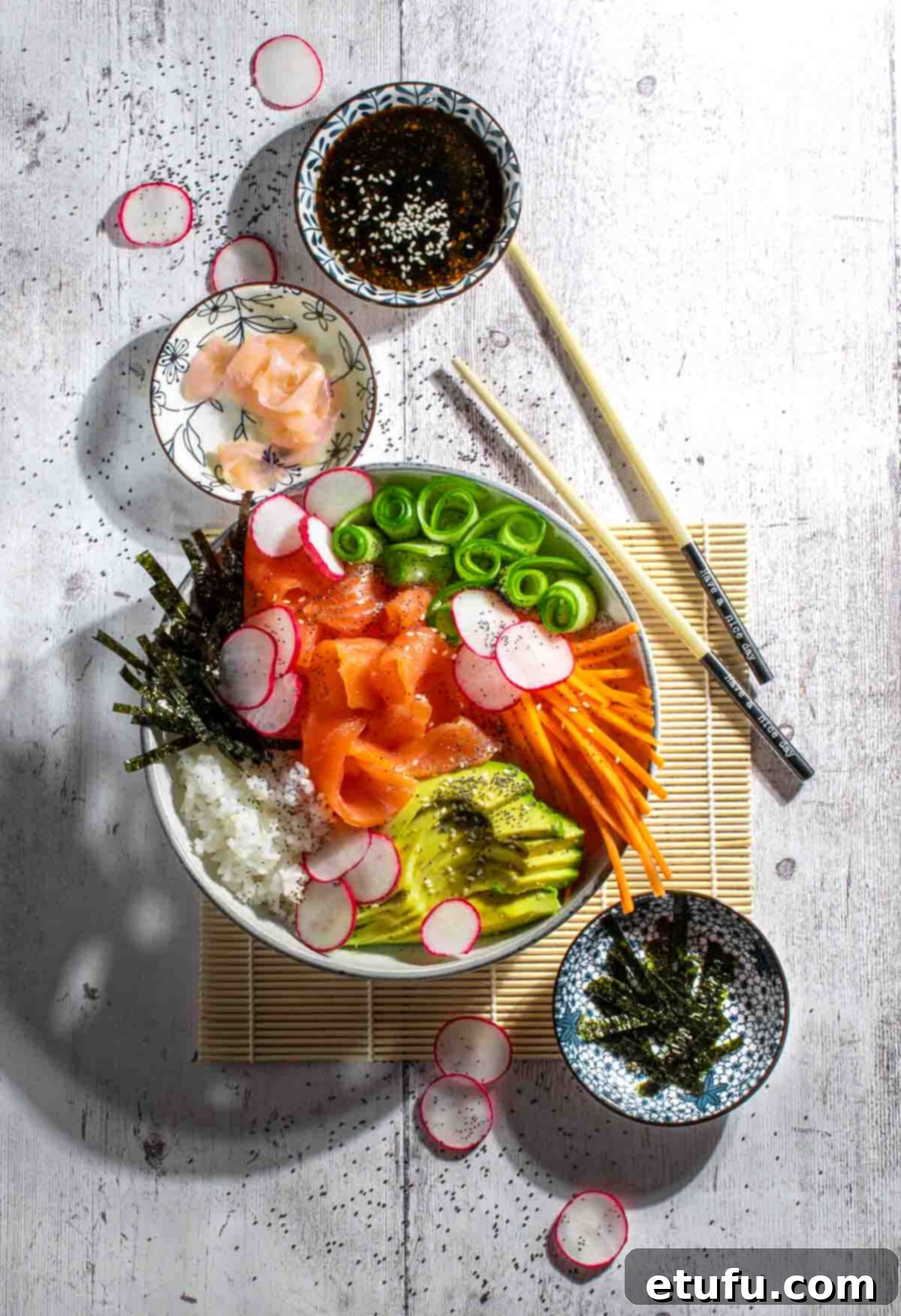
Fast Facts – Japan: A Glimpse into the Land of Sushi

Beyond its iconic culinary contributions, Japan is a fascinating nation rich in culture, history, and unique traditions. Understanding a little about the country that inspired this dish adds an extra layer of appreciation to your dining experience.
| Location | Japan is an island country gracefully situated in East Asia. It comprises four primary islands: Honshu, Hokkaido, Kyushu, and Shikoku, along with a vast archipelago of thousands of smaller islands. This unique geography has profoundly shaped its culture and cuisine. |
| Language | The official language of Japan is Japanese, a distinctive language known for its complex yet beautiful writing system. This system skillfully combines three main scripts: kanji (Chinese characters), hiragana (phonetic script for native Japanese words), and katakana (phonetic script primarily for foreign words). |
| Population | With a vibrant population of approximately 126 million people, Japan is one of the most densely populated countries in the world, renowned for its bustling cities and serene natural landscapes. |
| Trivia: Adult Adoption | An intriguing tradition in Japan is adult adoption, where a non-family member is legally and socially accepted as an adult child within a family. This practice has existed for centuries, serving as a unique method for families to expand their lineage, secure property, and preserve their family name, particularly when there are no male heirs or when a successor with specific skills is desired, extending beyond mere blood relations. |
Why You’ll Fall in Love with This Deconstructed Sushi Bowl
This deconstructed sushi salad isn’t just a meal; it’s a delightful experience packed with flavor, health benefits, and creative freedom. Here’s why this recipe will quickly become a favorite in your kitchen:
- Exceptionally Healthy and Nutritious: Bursting with a vibrant array of fresh, crisp vegetables and succulent omega-rich salmon, this salad is a powerhouse of essential vitamins, minerals, and healthy fats. It’s a guilt-free indulgence that nourishes your body from the inside out.
- Perfect for Sashimi Skeptics: For those who enjoy the flavors of sushi but prefer cooked fish, our recipe thoughtfully utilizes smoked salmon. This makes it an ideal option for individuals who might not be keen on sashimi (raw fish), offering a familiar and delightful taste.
- Satisfy Your Sushi Cravings, Effortlessly: True sushi enthusiasts will find this deconstructed bowl an excellent way to curb those intense sushi cravings. By incorporating perfectly seasoned sushi rice and delicately shredded nori sheets, it delivers all the iconic, umami-rich flavors of your favorite sushi rolls, but in a much simpler format.
- Visually Stunning Presentation: This sushi salad is a feast for the eyes as much as it is for the palate. Its colorful components and artful arrangement make it an impressive centerpiece for any table, perfect for entertaining guests or simply brightening up a weeknight dinner.
- Highly Customizable to Your Taste: The beauty of this recipe lies in its versatility. It’s incredibly adaptable, allowing you to easily swap ingredients based on what’s seasonal, what you have on hand, or what your family prefers. Don’t hesitate to experiment and make it truly your own!
- Easy to Make and Fun to Style: Forget the complexities of rolling sushi. This recipe simplifies the process, focusing on easy prep and assembly. The creative freedom in styling your bowls makes it a genuinely fun and engaging cooking project for all ages.
- Versatile and Delicious Dressing: The accompanying salad dressing, a harmonious blend of soy sauce, rice vinegar, honey, oil, and a hint of wasabi, is nothing short of delicious. Its balanced sweet, savory, and tangy profile not only elevates this sushi salad but can also be used to enhance other salads, making it a valuable addition to your culinary repertoire.
Key Ingredient Notes and Smart Substitutions
To ensure the best possible sushi salad experience, understanding your ingredients is key. Here’s a closer look at some essential components and how you can adapt them to your preferences and dietary needs.
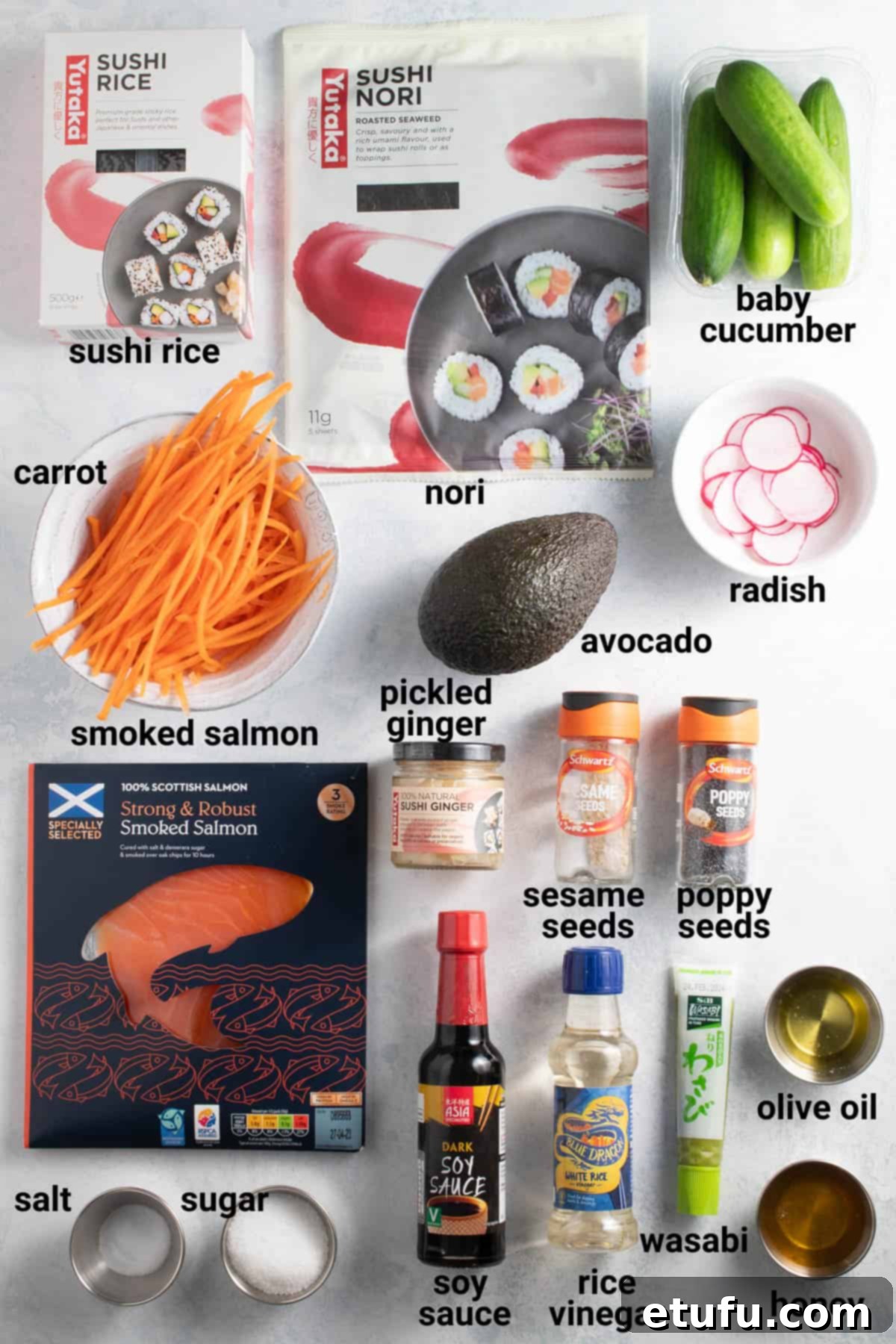
Sushi Rice
This is the cornerstone of any great sushi dish. Look for short-grain rice specifically labeled “Sushi Rice” in the Asian food aisle of most supermarkets. Its characteristic stickiness and slightly firm texture when cooked are crucial for the authentic sushi experience.
It’s imperative to rinse the sushi rice thoroughly before cooking. Short-grain rice, unlike its long-grain counterparts, is naturally very starchy. If you skip the rinsing step, the excess starch on the surface of the grains will cause the rice to become excessively sticky, gummy, or glutinous when cooked, rather than perfectly tender and separable. Rinsing removes this surface starch, allowing the grains to cook evenly and achieve the ideal sushi texture. This also ensures a cleaner, purer flavor profile.
Rice Vinegar
Also known as rice wine vinegar, this ingredient is fundamental to the seasoning of sushi rice, providing its signature tang and subtly sweet aroma. While some sources suggest substituting rice vinegar with apple cider vinegar, we have not personally tested this. If you decide to experiment with apple cider vinegar, we’d love to hear about your results in the comments!
Smoked Salmon
Our recipe uses delicious smoked salmon for its rich flavor and accessible texture, making it perfect for those who prefer cooked fish. However, this is a highly versatile component:
- For Traditionalists: Feel free to use high-quality salmon sashimi or tuna sashimi if you enjoy raw fish. Always ensure it is “sushi-grade” for safety.
- Budget-Friendly Option: A good quality tinned tuna (drained and flaked) can also work wonderfully, providing a different but equally delicious flavor profile.
- Vegetarian/Vegan Alternatives: To make this dish entirely plant-based, simply omit the fish. Excellent substitutes include marinated and grilled tofu, pan-fried tempeh, or even thinly sliced mushrooms for an earthy umami flavor.
Baby Cucumbers
Also known as Persian cucumbers, these small, snack-sized cucumbers have become increasingly common in most grocery stores due to their convenience and appealing texture. While they taste very similar to larger English cucumbers, they boast fewer seeds and a thinner skin, making them absolutely ideal for creating the delicate, elegant cucumber ribbons that add a refreshing crunch and visual appeal to this salad. Their firm texture holds up beautifully when peeled into ribbons.
How to Craft Your Perfect Sushi Salad Bowl
Creating this deconstructed sushi salad is a rewarding process, broken down into manageable steps. Follow these instructions for a culinary masterpiece that’s as fun to make as it is to eat.
To Make Perfect Sushi Rice: The Foundation of Your Bowl
Achieving perfectly seasoned sushi rice is crucial for the authentic flavor of your sushi salad. Don’t skip these steps!
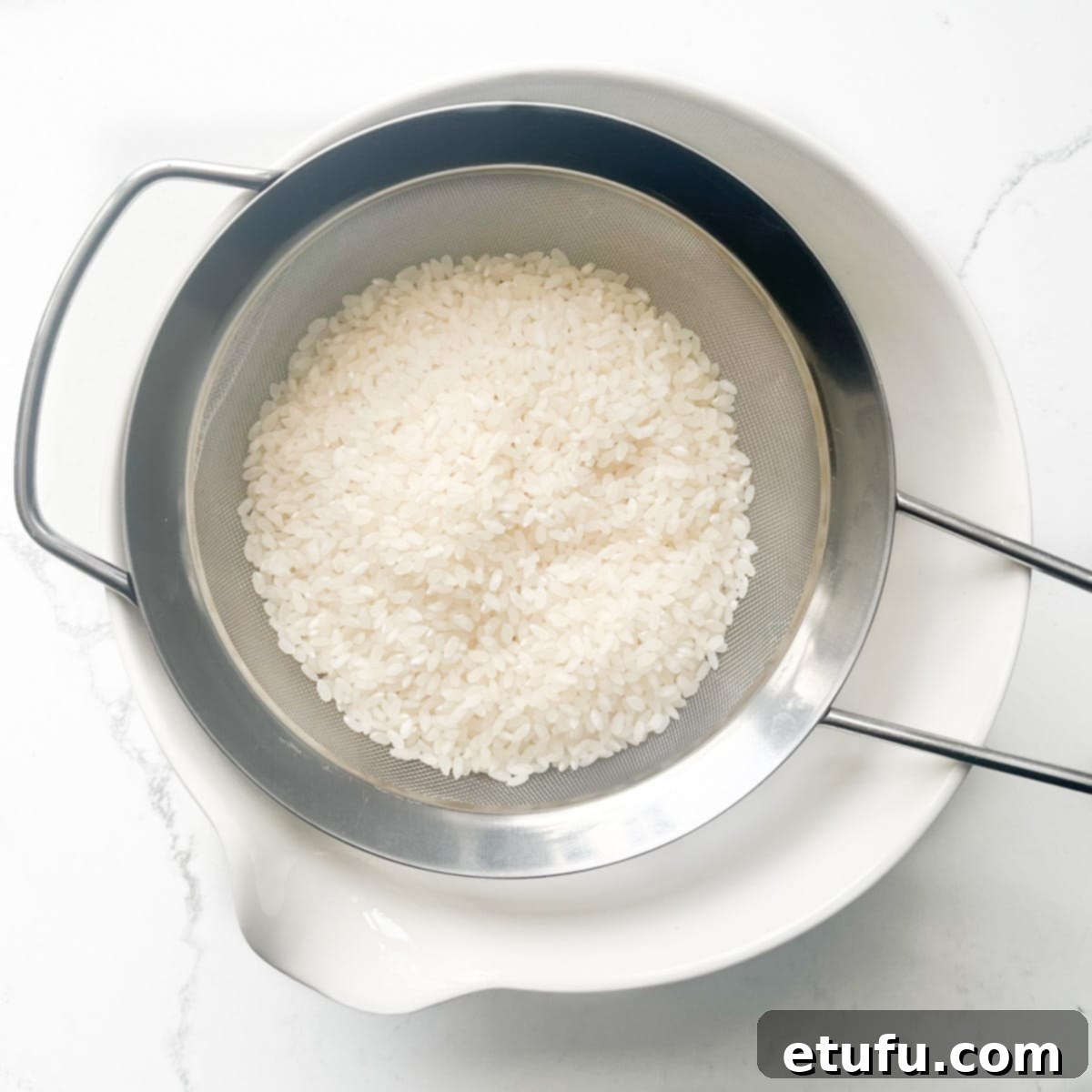
- Rinse the Rice Thoroughly: Place the uncooked sushi rice in a fine-mesh sieve. Rinse it under cold running water, continuously agitating the rice, until the water draining from the bottom of the sieve runs completely clear. This usually takes several minutes. If your kitchen tap has a spray head, it works exceptionally well for this task. Alternatively, you can rinse the rice in a bowl, changing the water about three times until it remains transparent. This step is vital to remove excess starch and prevent overly sticky rice.
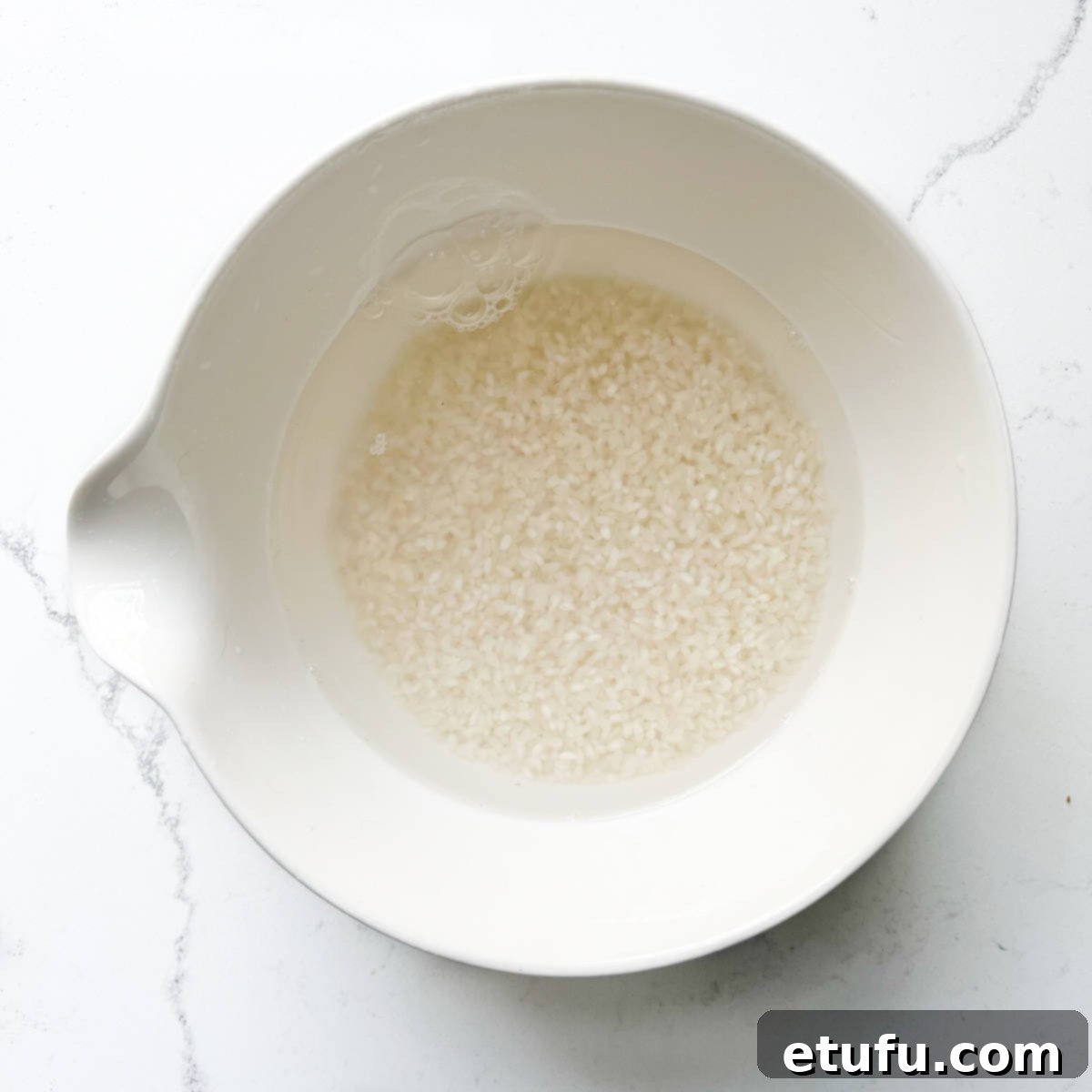
- Soak for Even Cooking: Transfer the rinsed rice to a clean bowl and add just enough cold water to fully cover it. Allow the rice to soak for 30 minutes. Soaking is a critical step that enables the rice grains to absorb water right to their core, ensuring that they cook uniformly and achieve a tender, yet firm, texture. You can visibly observe the rice grains swelling during this soaking period when comparing it to the dry rice.
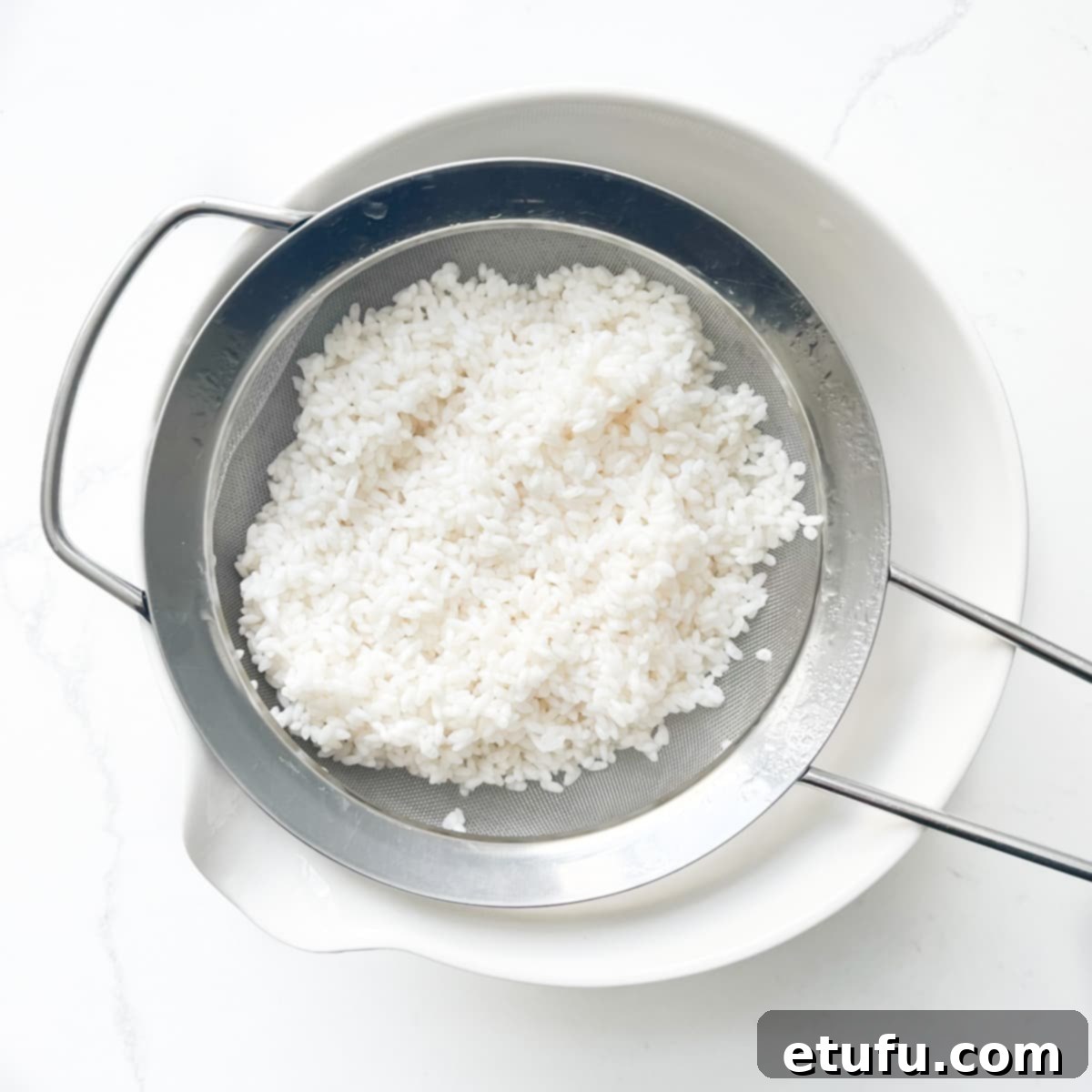
- Drain Completely: After soaking, drain the rice thoroughly using the fine-mesh sieve. Let it sit in the sieve over a bowl for an additional 5 minutes to ensure all excess water has drained away. This prevents the rice from becoming waterlogged during cooking.
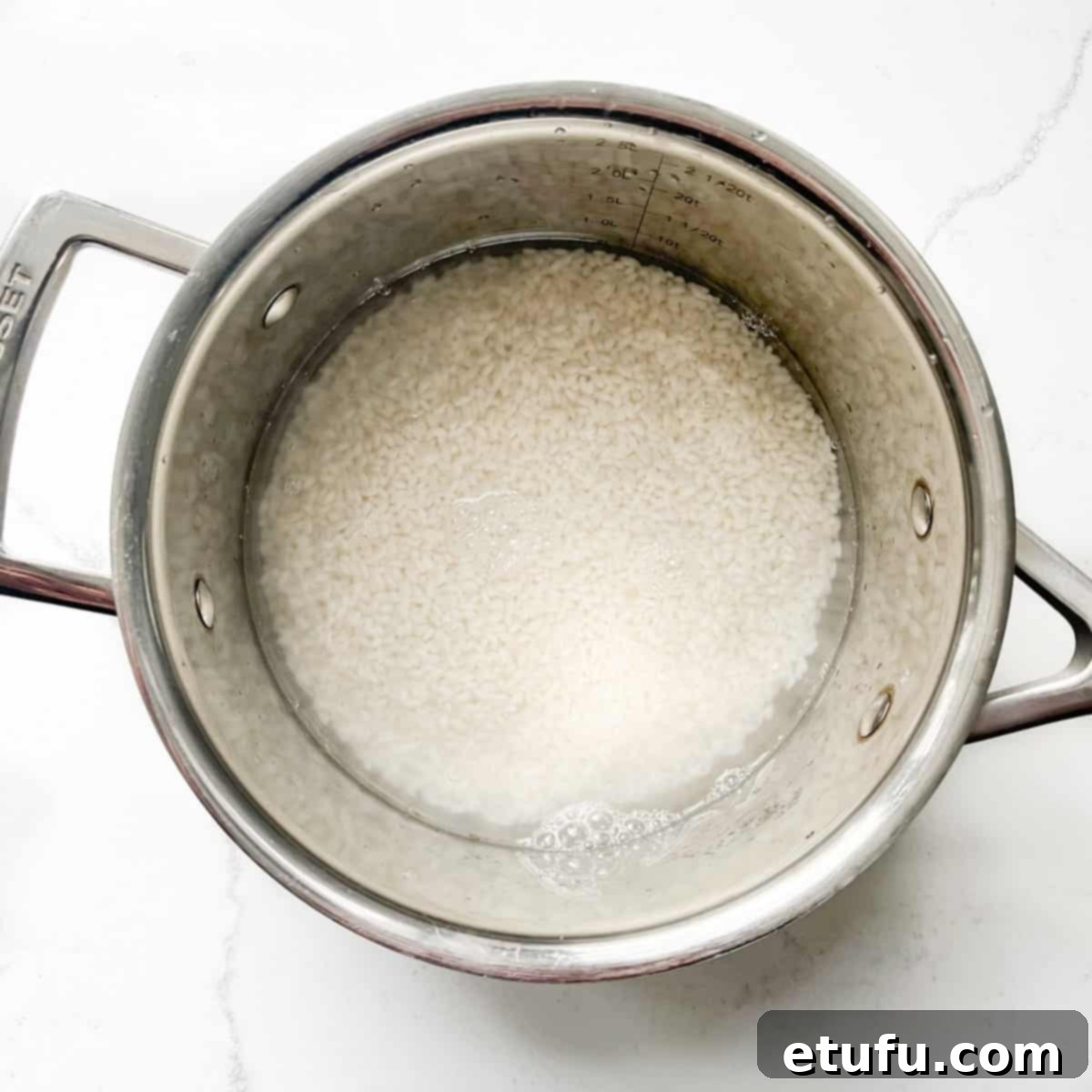
- Cook the Rice: Transfer the well-drained rice to a medium saucepan with a tight-fitting lid. Add precisely 330ml of fresh cold water. Bring the water to a gentle simmer over medium-high heat. As soon as it simmers, reduce the heat to the lowest setting, cover the saucepan tightly with its lid, and cook undisturbed for exactly 10 minutes. Resist the urge to lift the lid, as this releases steam crucial for cooking.
- Rest and Prepare Seasoning: Once the 10 minutes of cooking are up, remove the saucepan from the heat, but do not lift the lid. Let the rice rest, still covered, for a further 10 minutes. This resting period allows the steam to redistribute, resulting in perfectly fluffy grains. While the rice rests, seize the opportunity to prepare your sushi seasoning.

- Mix Sushi Seasoning: In a small, separate bowl, combine three tablespoons of rice vinegar, two tablespoons of granulated sugar, and one teaspoon of fine salt. Stir the mixture well and let it sit for a minute or two, allowing the sugar and salt to dissolve completely. Stir again to ensure an even consistency. This forms the essential sushi seasoning that gives the rice its characteristic flavor.

- Transfer the Rice: When the rice has finished resting, gently transfer it into a large bowl. For best results, slightly dampen the inside of the bowl with a little water beforehand; this simple trick helps prevent the sticky rice from adhering to the sides.

- Season the Rice: Evenly drizzle the prepared vinegar mixture over the warm rice. Using a wooden spoon or a wooden spatula (avoid metal, as it can damage the delicate grains and react with the vinegar), gently fold and mix the seasoning into the rice. Employ a cutting motion through the rice with your utensil; this technique helps to distribute the seasoning evenly without mashing the grains, while also separating the rice for a pleasing texture.
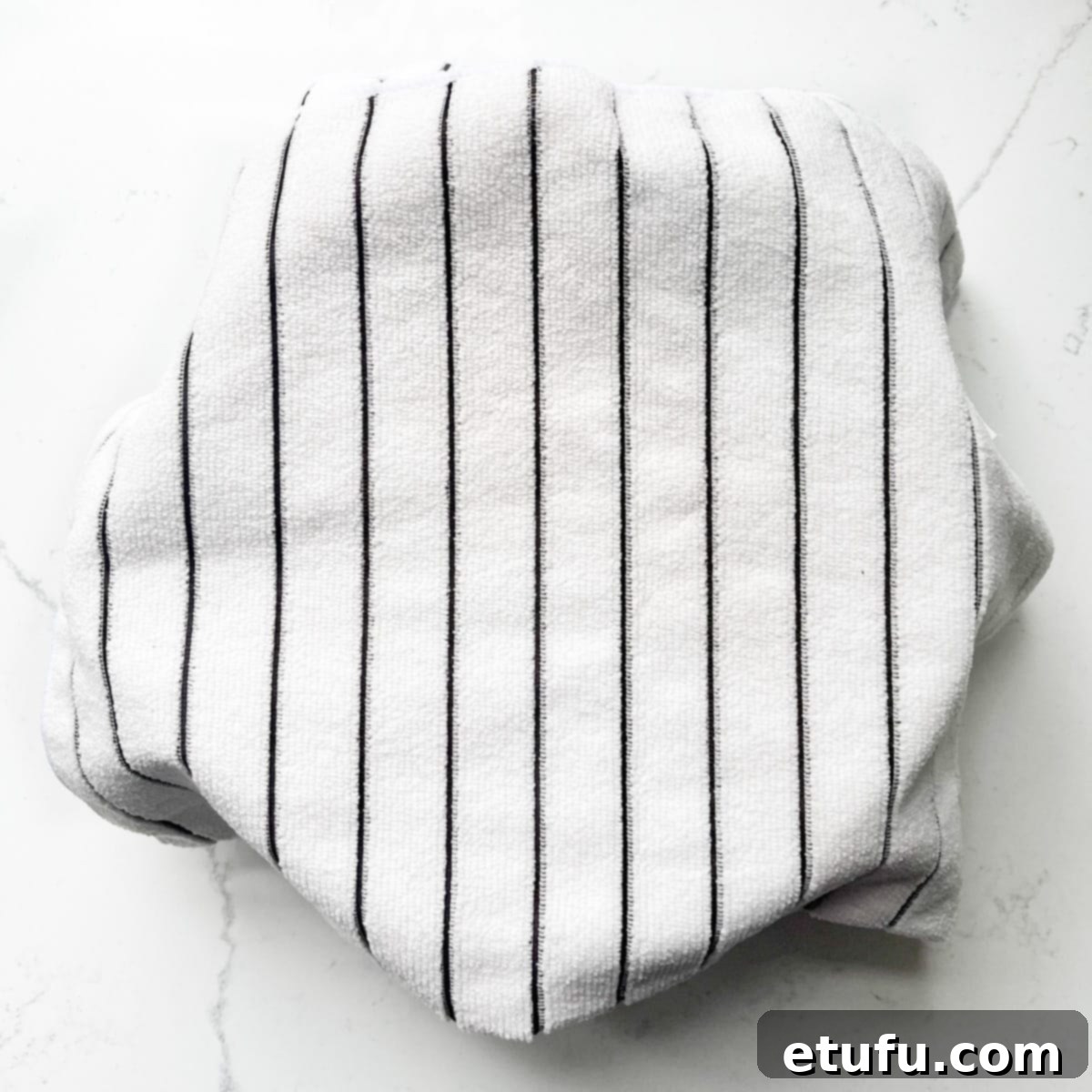
- Cool the Rice: Cover the bowl of seasoned rice with a damp kitchen towel. Set it aside and allow it to cool down to room temperature. This cooling process is crucial before assembling the salad, as warm rice can wilt your fresh toppings. Use this time to prepare your salad dressing and all the colorful toppings.
To Make the Zesty Salad Dressing
This simple yet flavorful dressing ties all the elements of your sushi salad together, adding a perfect balance of savory, sweet, and spicy notes.

- Whisk the Dressing: In a small bowl, combine all the ingredients for the dressing (dark soy sauce, rice vinegar, olive oil, honey, and wasabi). Whisk everything together thoroughly, paying extra attention to ensure the wasabi paste fully dissolves into the liquid, creating a smooth, emulsified dressing. Once mixed, pour the dressing into a small jug or a decorative bowl, ready to be served alongside your vibrant sushi salad.
Prepare Your Fresh Salad Toppings
The beauty of this sushi salad lies in its diverse textures and colors. Precise preparation of your toppings enhances both the visual appeal and the eating experience.
- Prepare Smoked Salmon: Gently separate the individual slices of smoked salmon. Then, using a sharp knife, cut each slice into elegant, long ribbons, approximately 2.5cm (1 inch) thick. These ribbons will create a beautiful, undulating effect in your bowl.
- Slice Avocados: Carefully pit and peel the avocados. Slice them into thin, even pieces. To prevent browning, you can lightly brush the avocado slices with a little lemon or lime juice if you’re not assembling the salad immediately.
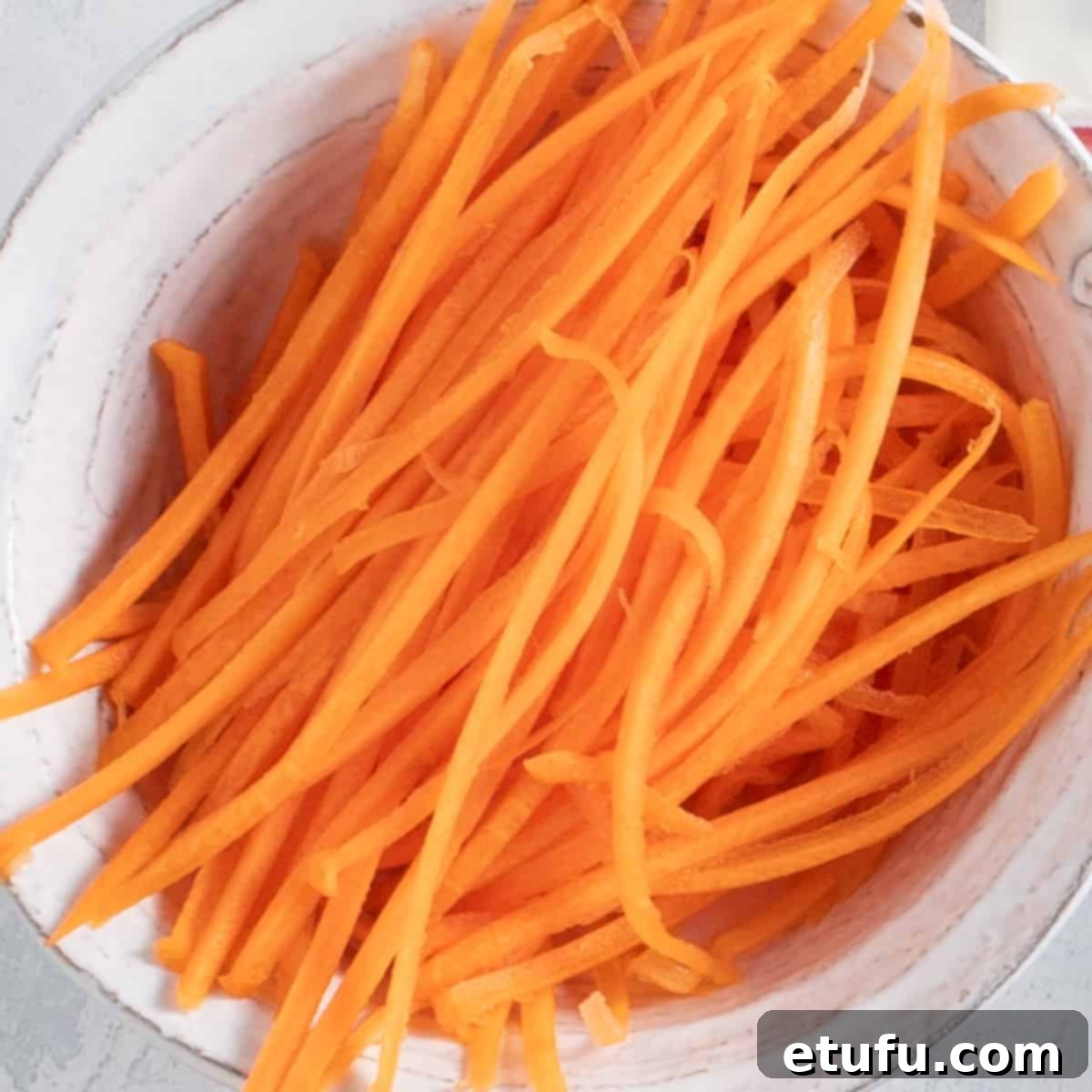
- Julienne Carrots: Peel the carrot and then slice it into fine julienne strips. This can be done meticulously by hand with a sharp knife, or for speed and uniformity, you can use a mandoline slicer with a julienne blade. Here’s a helpful video on how to Julienne carrots by hand if you need a visual guide.

- Create Cucumber Ribbons: Using a vegetable peeler (a standard potato peeler works perfectly), carefully peel long, thin strips lengthwise from the baby cucumbers to create delicate ‘ribbons’. Once you reach the seedy center of the cucumber, simply turn it around and repeat the process from the other side until you’ve used most of the firm flesh.
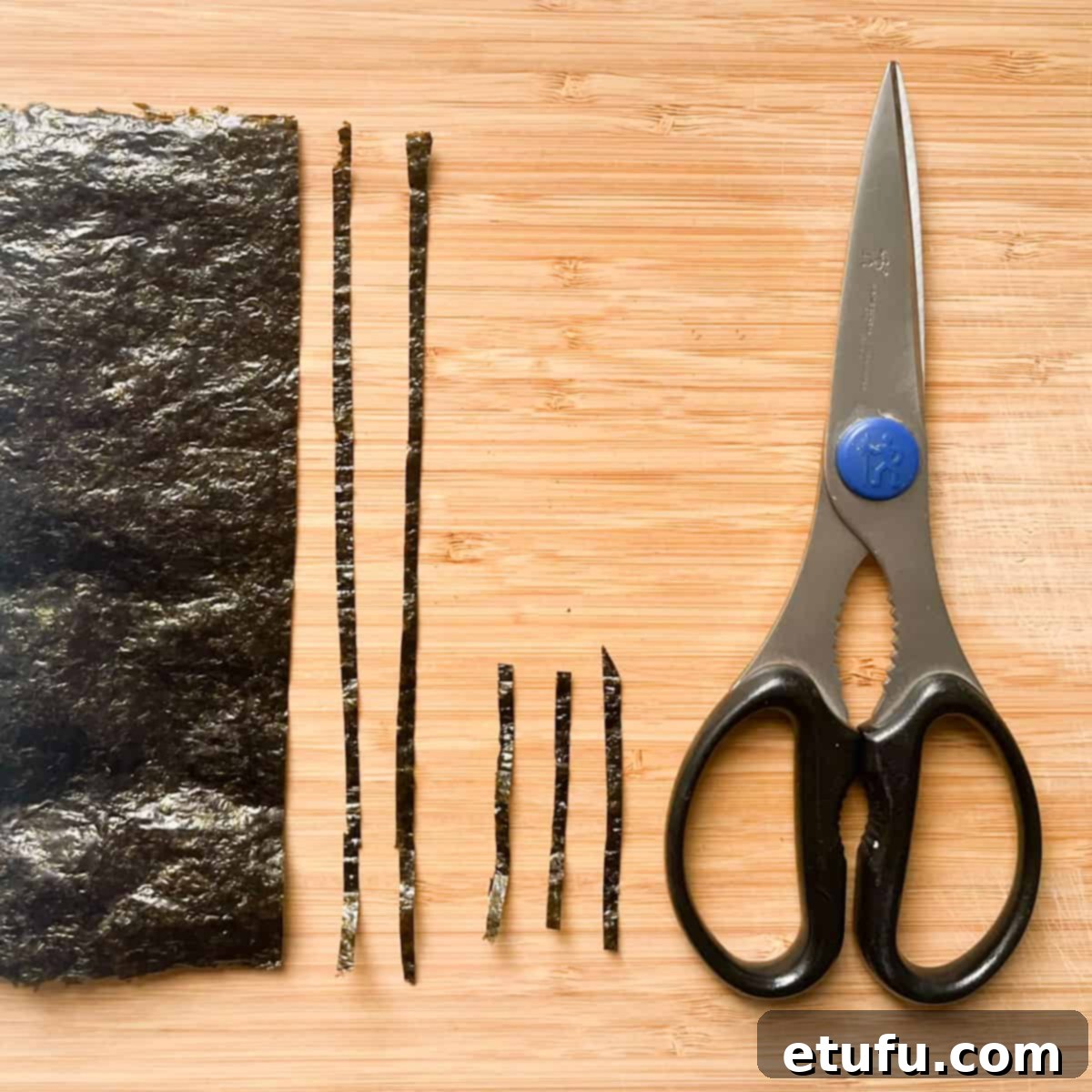
- Shred Nori: Take a sheet of sushi nori and, using a pair of sharp kitchen scissors, cut it into very thin, delicate strips. Imagine the consistency of paper that has just passed through a shredder – this fine cut will allow the nori to beautifully integrate with the other ingredients, adding that unmistakable sushi flavor and a subtle textural contrast.
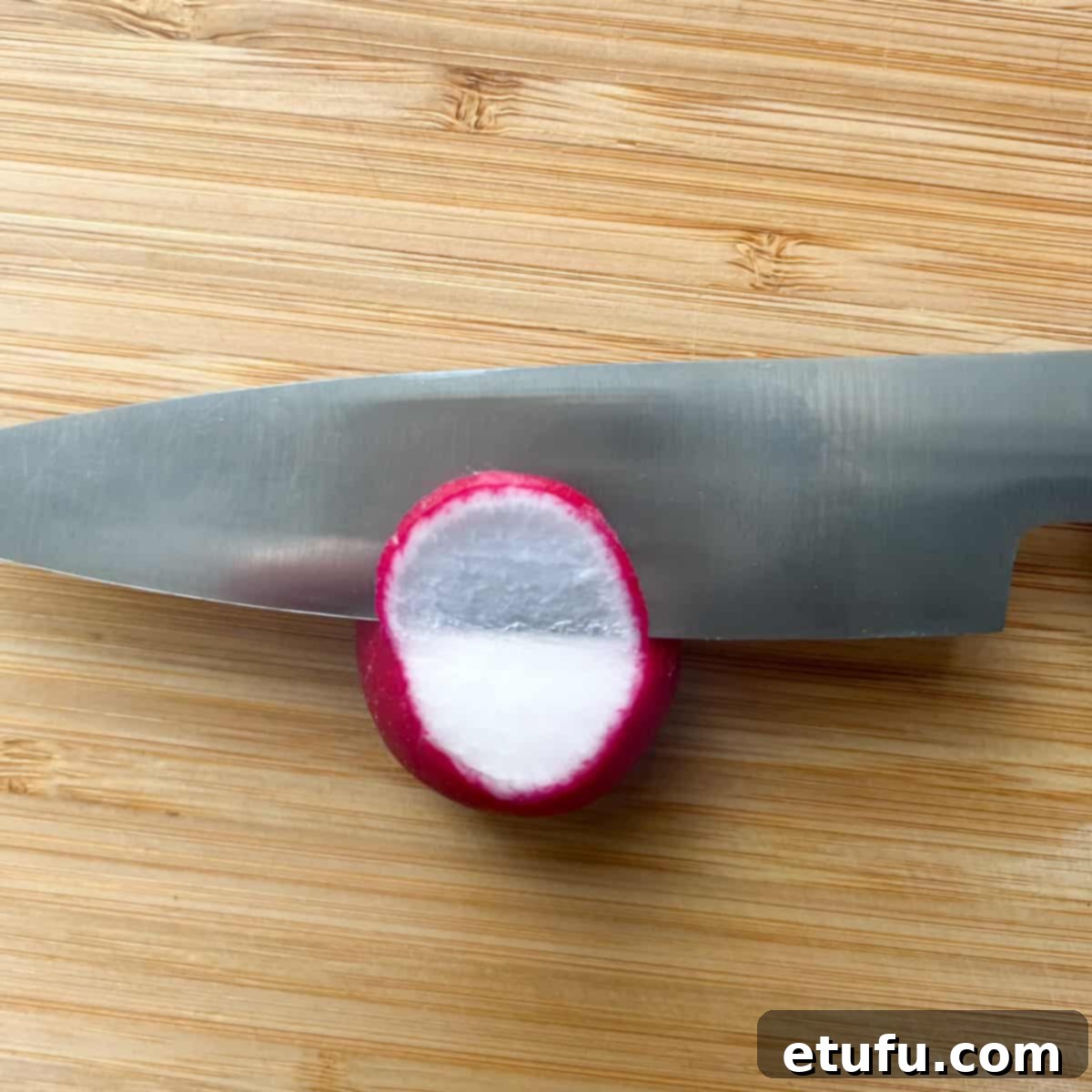
- Slice Radishes: Trim the tops and tails off the radishes. Using a very sharp knife or a mandoline, slice them into paper-thin rounds.
Top tip for wafer-thin slices: To achieve truly translucent, paper-thin slices, hold the radish so the sliced surface faces towards you. As you carefully slice through it, ensure you can almost ‘see’ the knife blade through the radish itself. This visual cue is an excellent indication of how thin you’re slicing, allowing you to adjust your pressure and speed accordingly. Remember, slow and steady precision will always yield the best results for delicate cuts.
Artfully Assembling Your Deconstructed Sushi Salad Bowls
The presentation is key to this deconstructed sushi experience. While these instructions provide a guide, feel free to let your creativity shine and arrange your ingredients in any way that pleases you!
**Please note, this is how we arrange our salad; you can put your own spin on it, or slice the vegetables in other unique ways to create your personalized masterpiece.
- Layer the Rice: Begin by dividing the cooled, seasoned sushi rice equally among four individual serving bowls. Gently press the rice down to form an even base.
- Add the Salmon Centerpiece: Carefully pile the delicate ribbons of smoked salmon into the middle of each rice bowl, creating a focal point for your salad.
- Fan the Avocado: Artfully fan out a few thin slices of avocado on top of the rice, positioning them next to the salmon. Their creamy texture and vibrant green color add a lovely contrast.
- Place Julienned Carrots: Gather a small bunch of the bright orange julienned carrots and strategically place them towards one side of the bowl. For an appealing visual, allow some of the carrot strips to extend slightly over the rim of the bowl, adding height and dimension.
- Nestle Cucumber Ribbons: Take the long cucumber ribbons and loosely roll each one into a small spiral. Nestle these spirals together on the rice, creating a cluster. Keeping them close to each other will help them maintain their spiral shape, and a gentle press into the rice will secure them in place.
- Integrate Shredded Nori: Place a generous bunch of the thinly shredded nori strips onto the rice. To maintain visual interest and balance the colors and textures, position the nori on the opposite side of the bowl from the carrots, as their shredded appearance is somewhat similar.
- Dot with Radishes: Distribute the paper-thin radish slices across the salad, filling any visible gaps with their beautiful pink and white hues. For a naturally pleasing aesthetic, arrange them in small groups, typically three or five slices together.
- Highlight the Rice Base: Intentionally leave a small area of the fluffy, seasoned sushi rice bare. This subtle detail showcases the foundation of your deconstructed sushi, inviting diners to appreciate the carefully prepared rice underneath the vibrant toppings.
- Sprinkle for Crunch and Color: Lavishly sprinkle a mix of sesame seeds (both white and black) and poppy seeds over the entire salad. This final touch adds an inviting pop of color, an extra layer of texture, and a nutty aroma. The black sesame seeds, in particular, provide a striking contrast against the green avocado and pristine white rice.
- Serve with Accompaniments: Present the beautifully assembled sushi salad bowls alongside the prepared salad dressing. For an authentic experience, also offer pickled sushi ginger (gari) and extra wasabi paste on the side, allowing each diner to customize their flavors. A small dish of black pepper and sea salt can also be provided for those who wish to season their salad further to their personal liking.
Creative Variations to Explore
One of the greatest joys of this sushi salad is its adaptability. Feel free to experiment with these variations to suit your taste and dietary preferences, making each bowl uniquely yours.
- Other Exciting Vegetables: Expand your palette by incorporating additional fresh vegetables such as thinly sliced bell peppers (red or yellow for color), vibrant edamame beans (shelled), crisp snow peas, crunchy bean sprouts, thinly sliced green onions (scallions), or tender baby spinach. Each addition brings new textures and nutrients.
- Diverse Protein Options: Beyond smoked salmon, the possibilities for protein are endless. Consider:
- Sashimi: High-quality, sushi-grade salmon or tuna sashimi for a more traditional raw fish experience.
- Cooked Seafood: Succulent cooked shrimp or prawns, or the convenience of imitation crabmeat (crab sticks), which adds a delicate sweetness.
- Eggs: A protein-rich hard-boiled egg, sliced or chopped, can add a different dimension.
- Grilled Chicken/Beef: Thinly sliced grilled chicken or beef can also be a delicious Western-inspired addition.
- Alternative Rice Base: If you’re looking for a healthier or different grain option, you can easily skip the sushi rice and serve the vibrant toppings over nutritious brown rice instead. This offers a nuttier flavor and more fiber.
Crafting a Vegetarian or Vegan Sushi Salad
Transforming this delightful sushi salad into a plant-based marvel is simple and doesn’t compromise on flavor or satisfaction. Follow these easy adjustments:
- Protein Swap: Replace the smoked salmon (or any fish) with a flavorful plant-based protein. Grilled, baked, or pan-fried tofu, marinated tempeh, or even roasted sweet potato cubes make excellent and satisfying alternatives. Ensure your tofu is well-pressed and seasoned for optimal taste and texture.
- Honey Alternative: If you’re following a strict vegan diet, simply swap the honey in the salad dressing for an equal amount of agave syrup or maple syrup. Both will provide the necessary sweetness and viscosity without animal products.
Elevating Your Serving Experience
To fully enjoy your deconstructed sushi bowl, consider these serving suggestions that enhance both flavor and presentation.
- Classic Accompaniments: Serve the sushi bowls with traditional Japanese condiments such as extra pickled sushi ginger (gari), a dollop of pungent wasabi paste, a drizzle of creamy Japanese mayonnaise, or a few drops of nutty sesame oil to add depth.
- Individual or Communal: While individual bowls are perfect for personalized plating, you can also create one large, stunning communal sushi salad platter for family-style dining. Guests can then serve themselves, appreciating the vibrant arrangement.
- Embrace Chopsticks: For an authentic and enjoyable dining experience, serve the salad with chopsticks. It adds to the ritual and enhances the appreciation of each component.
- Temperature Matters: Always ensure the seasoned sushi rice has completely cooled to room temperature before adding any fresh vegetables and other toppings. This prevents the delicate greens from wilting and keeps the entire salad crisp and refreshing.
Complementary Side Dishes for Sushi Rice
While your deconstructed sushi bowl is a complete meal, pairing it with additional Japanese-inspired side dishes can elevate your dining experience to a lavish feast. Here are some fantastic options:
- Miso Soup: A comforting and flavorful bowl of traditional miso soup provides a warm, savory contrast to the cool salad.
- Gyoza and Gyoza Sauce: Pan-fried or steamed gyoza dumplings, accompanied by their tangy dipping sauce, add a delightful textural and flavor dimension.
- Pickled Vegetables: Assorted Japanese pickled vegetables (tsukemono) offer a refreshing, tangy crunch that cleanses the palate.
- Tempura: Light and crispy vegetable tempura or shrimp tempura provides a delicious fried element that contrasts beautifully with the fresh salad.
- Sushi Rolls: For the ultimate sushi lover, you can never have enough! Serve a small selection of traditional sushi rolls alongside your deconstructed bowl for a truly immersive Japanese meal.
Storage and Food Safety Guidelines
To ensure maximum freshness and safety, especially when dealing with cooked rice and fresh ingredients, proper storage is paramount.
As with most salads featuring delicate components, this sushi salad is best enjoyed freshly made, when all ingredients are at their crispest and most flavorful. However, it will still be perfectly acceptable the following day if stored correctly. Ensure it is kept covered in an airtight container and promptly refrigerated. It is crucial to note that cooked rice is only safe to consume within 24 hours of preparation, so aim to finish any leftovers within this timeframe.
If you plan to prepare this for packed lunches, transport it in an insulated bag with an ice pack and place it in a fridge as soon as you arrive at your destination. It’s also an excellent choice for a picnic, but remember to keep it in a cooler bag, refrigerated, right up until the moment you intend to eat it.
Important Safety Note for Sashimi: If you choose to incorporate raw fish (sashimi) into your deconstructed sushi bowl, always buy sushi-grade sashimi. This designation ensures that the fish has been meticulously handled, processed, and stored according to strict safety standards, making it safe for raw consumption. Never use regular grocery store fish for sashimi unless it is explicitly labeled sushi-grade.
More Delicious Rice Recipes You Might Enjoy
If you loved this sushi salad, you might be interested in exploring other delightful rice-based dishes from our collection:
- Fragrant Brown Rice Salad
- Healthy Sweet Potato Salad Recipe
- Easy Khao Pad Recipe (Thai Fried Rice)
Explore More Asian-Inspired Recipes
Continue your culinary journey through Asia with these tempting dishes:
Chinese Lettuce Wraps – Yuk Sung
Sriracha Noodles (Dragon Noodles)
Nepalese Chicken Curry
Creamy Oven-Baked Pasanda Curry
Flavorful Satay Chicken Stir Fry with Udon Noodles
Quick and Easy Noodles with Prawns
Deconstructed Sushi Bowl Recipe

Sushi Salad – Deconstructed Sushi Bowl
This visually stunning sushi salad is pretty much sushi as you know it, but deconstructed. It is the perfect fusion of Japanese and Western cuisine. Maybe you’ve always wanted to make homemade sushi but you don’t have the equipment, or it just feels too overwhelming – this salad is for you! It’s healthy, nutrient-rich, refreshing, crunchy and the best of all, it does really taste exactly like sushi.
Rating: 5 out of 5 stars based on 38 votes.
Print Recipe | Save Recipe
Course: Salad | Cuisine: Japanese
Prep Time: 10 minutes | Cook Time: 20 minutes | Soaking time: 30 minutes | Total Time: 1 hour
Servings: 4 servings
Calories: 571kcal
Author: Maretha Corbett
Equipment
- 1 medium saucepan with a lid
Ingredients
For the Sushi Rice
- 250 grams uncooked sushi rice
- 330 millilitre water
- 3 tablespoons rice vinegar
- 2 tablespoons sugar
- 1 teaspoon salt
For the Salad Dressing
- 100 millilitre dark soy sauce
- 4 teaspoons rice vinegar
- 1 tablespoon olive oil
- 2 tablespoons honey
- ½ teaspoon wasabi – or more, to taste
For the Salad
- 200 grams smoked salmon
- 2 avocados
- 1 large carrot – or two medium
- 4 baby cucumbers – or Persian cucumbers
- 4 radishes
- 1 sheet of sushi nori
- sesame and poppy seeds for sprinkling
- sushi pickled ginger for serving
Instructions
To Make Perfect Sushi Rice
- Add the rice to a fine mesh sieve and rinse it under running cold tap water until the water runs completely clear. If you have a spray head on your tap, that works excellently for rinsing rice in a sieve. You can also rinse it in a bowl and on average it will need about three rinses.
- Add the rinsed rice to a bowl and add just enough water to cover it. Let it soak for 30 minutes. Soaking allows the rice to absorb water right to the centre of each grain, which will result in even cooking.
- Drain the rice and let it sit in the sieve over a bowl for 5 minutes to drain completely.
- Add the rice to a saucepan along with the 330ml fresh cold water. Bring the water up to a simmer, cover tightly with the lid and turn the heat to low. Cook undisturbed for 10 minutes.
- After 10 minutes, remove the saucepan from the heat and let the rice rest for a further 10 minutes with the lid on. In the meantime, get started on the sushi seasoning.
- In a small bowl, mix together the three tablespoons rice vinegar, two tablespoons sugar and 1 teaspoon salt.
- When the rice is ready, tip it into a large bowl that’s been slightly dampened with water on the inside. This will help prevent the rice from sticking to the sides.
- Evenly drizzle over the sushi seasoning over the warm rice. Using a wooden spoon or a wooden spatula, gently mix the seasoning into the rice (metal spoons can damage the soft grains of the rice and may also react to the vinegar). Using a cutting motion through the rice with the spoon helps to distribute the seasoning, as well as separating the rice.
- Cover the bowl of rice with a damp kitchen towel and set it aside to cool whilst you get on with preparing the salad dressing and toppings.
To Make the Salad Dressing
- Add all the ingredients for the dressing to a small bowl and whisk together, taking extra care that the wasabi dissolves into the liquid. Pour into a small jug to serve with your salad.
Prepare the Salad Toppings
- Separate the smoked salmon into individual ‘sheets’ and cut each sheet into long ribbons of about 2.5cm/1″ thick.
- Pit and peel the avocados and slice into thin slices.
- Peel the carrot and slice into julienne strips. You can do this by hand or by using a mandoline.
- Using a potato peeler, peel long strips lengthways from the cucumber to create ‘ribbons’. When you almost reached the centre of the cucumber, turn it around and repeat from the other side.
- Using scissors, cut the nori into very thin strips – think paper when it’s gone through a shredder.
- Top and tail the radishes and slice into paper-thin slices.
Assembling the Sushi Salad
- Divide the rice into four individual bowls.
- Pile the salmon ribbons into the middle of each rice bowl.
- Fan out a few slices of avocado on top of the rice.
- Bunch together julienned carrots and place them towards the side of the bowl. We like to have them sticking out across the rim a little.
- Take the cucumber ribbons and loosely roll them up into small spirals. Nestle them together on the rice. If you keep them close to each other it stops them from unrolling. It also helps to lightly press them down into the rice.
- Place a bunch of the shredded nori onto the rice – Because they are similarly sliced to the carrots, place them on the opposite side of the bowl to keep it interesting.
- Dot the radishes across the salad where you see gaps, preferably in groups of three/five.
- Leave a small area of rice bare to show what’s underneath the toppings.
- Lavishly sprinkle over the sesame and poppy seeds for extra colour and texture. The black sesame seeds look great on the green avocado and the white rice.
- Serve the salad alongside the salad dressing with pickled sushi ginger and extra wasabi.
**Nutritional Data Disclaimer**
Please keep in mind that the nutritional information provided below is calculated by a third party and we cannot guarantee the accuracy. We try our best to give you the most accurate information, but we do not take responsibility for errors that may be present. Also, the nutritional value of the recipe may change depending on the exact brands and products used. We recommend that you consult with a qualified healthcare professional or registered dietitian for personalized advice on your dietary needs.
Nutrition
Calories: 571kcal | Carbohydrates: 80g | Protein: 19g | Fat: 21g | Saturated Fat: 3g | Polyunsaturated Fat: 3g | Monounsaturated Fat: 14g | Cholesterol: 12mg | Sodium: 2381mg | Potassium: 825mg | Fiber: 9g | Sugar: 18g | Vitamin A: 2830IU | Vitamin C: 14mg | Calcium: 50mg | Iron: 3mg
For food safety advice, including guidance on food allergies
